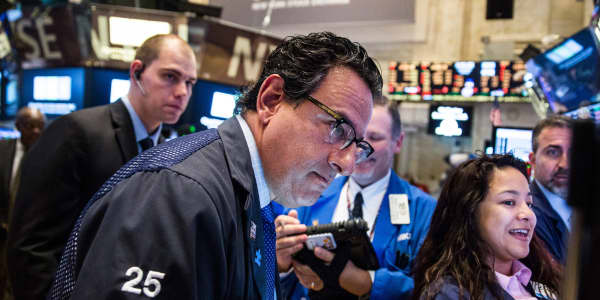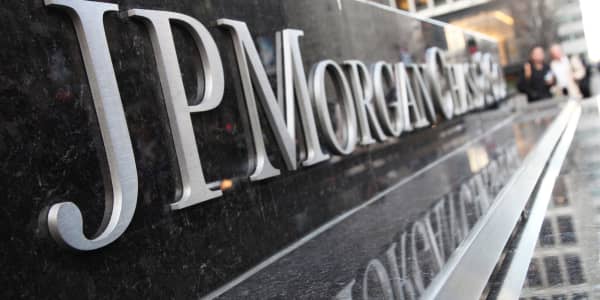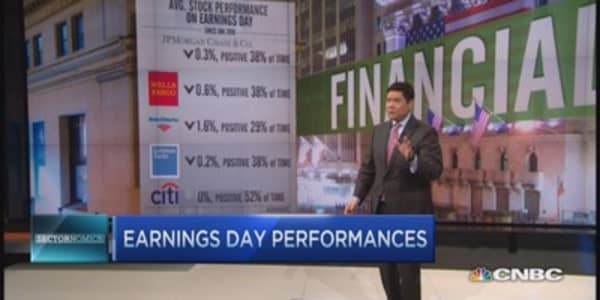Ever since the Federal Reserve began to suggest that it might one day begin to tighten money, a conventional wisdom has held: The way to bet on financial stocks is to invest in banks, figuring that higher rates will mean a bigger spread between super-low loan rates and the even lower interest they pay on deposits.
But what if that turns out to be wrong?
A cadre of Wall Streeters argue that a better bet in financial stocks right now may be asset managers, ranging from plain-vanilla mutual fund houses, like Invesco or BlackRock, to leveraged-buyout shops like Blackstone Group. Their argument: that the Fed's recent moves to back away from higher rates mean that stocks, rather than lending, are the place to be. And that asset managers offer a good way to profit from it.
Read MoreWhy Warren Buffett is always betting on bank stocks
"If the Fed stays somewhat loose in its policy, and if Europe and Japan have negative real rates, the Fed will more slowly raise rates," Citigroup analyst Bill Katz said, noting that the Fed's forecasts for the U.S. economy's growth were lowered at the September meetings of the Open Market Committee. "The main reason we have preferred the asset managers is we felt rate-sensitive names had been bid up already.''
Inflating fears
The minutes of the Fed's last meeting before this week's lent this argument a lot of weight, as did the market's gyrations in response to events from the Ebola outbreak in Africa to the ISIS crisis in Iraq and Syria. The minutes showed central bankers so concerned about low inflation that estimates of when the Fed will move to raise interest rates are being moved back, with some economists now arguing the first hike won't come until near the end of 2015.
That pushed the argument for banks' boosting their interest-rate margins well into the future, even as it mitigates the short-term risk of big capital losses on bonds that have benefited from central banks' low-rate policies.
On Wednesday afternoon, when the Fed released the notes from its just-finished two-day FOMC meeting, it said the fall in energy prices would keep inflation down in the near-term, but added, "the Committee judges that the likelihood of inflation running persistently below 2 percent has diminished somewhat since early this year." Some early reaction from the market judged the Fed tone to be slightly more hawkish. In any event, the Fed said it would maintain the federal funds rate at or near zero for a considerable time, as it has stated previously.
No one really knows what will happen. The technology has changed so much since the last time we had rising rates.Fred CannonKeefe, Bruyette & Woods research director
The upshot of all of this is that financial institutions tied to the stock market may be better bets than those that rely more heavily on lending, some analysts contend. Baby boomers' need to manage their retirement assets more actively than in the past is likely to offset any risk that boomers will pull away from stocks as they age, Sanford C. Bernstein analyst Lucas Montgomery said.
That plays into the hands of Invesco, a top pick of Citigroup analyst Katz.
The Atlanta-based mutual fund company, which manages $800 billion of assets, has about half of its assets in straight stock funds, with $150 billion more in balanced funds and so-called "alternative" funds, which invest in private equity, commodities and other assets mutual funds historically avoided.
The firm has also been successfully pushing into exchange-traded funds, which are so lightly managed that they improve Invesco's overall profit margins even though ETFs charge lower fees than traditional mutual funds, Katz said. Passive investments under management, including ETFs, have risen 15 percent since early 2013 versus 11 percent for actively-managed assets.
"They have good incremental profit margin potential there," Katz said.
The only way active managers can outperform?
Montgomery has also been a fan of T.Rowe Price, liking its focus on equities and solid fund performance, as well as an industry-leading concentration in defined-contribution retirement plans such as 401(k)s. He says 401(k)s will hold up better than people expect as boomers move toward retirement, because T. Rowe and others have created new products, such as funds that target a specific retirement target date, to help people manage market risks.
But T. Rowe's stock has lagged other asset managers due to a big drain of assets from its international institutional business, and it estimates. Profits were $303.6 million, or $1.12 a share, 4 cents below analysts' consensus forecasts. It has been outshined by its Baltimore neighbor, Legg Mason, the best performer of the last two years among big mutual fund companies, which has benefited from big stock repurchases.
Select mutual fund and ETF company year-to-date stock performance
(Source: Google Finance, through Oct. 28)
- Legg Mason: 17. 6 percent
- Invesco: 7.4 percent
- Federated Investors: 4.9 percent
- BlackRock: 4 percent
- T. Rowe Price Group: -4.72 percent
- Franklin Resources: -5.8 percent
- Affiliated Managers Group: -9 percent
- Eaton Vance: -14.3 percent
- WisdomTree Investments: -35 percent
"T. Rowe is cheap, but it could be a value trap," Montgomery said.
Analysts as a group are not especially high on BlackRock, the largest asset manager, with more than $4 trillion under management, which had big stock gains the last two years before dipping 3 percent so far in 2014. BlackRock hasn't recently been able to meet management's target for annual growth of 5 percent in its assets under management, excluding investment returns—the firm has boosted its assets under management by just under 4 percent in the last 12 months, excluding assets from acquired firms.
Read MoreIf rates do go up, investors should claim insurance stocks
BlackRock's topped earnings expectations in the third quarter, but shares are relatively expensive at 16.5 times this year's expected earnings, compared with 15.1 for Invesco. BlackRock has also been a weaker performer in managing stock funds—only 43 percent of its actively-managed stock assets are in funds that have matched or beaten their benchmarks for the last three years, the company said at a September investor conference. Despite that, tight expense control and stronger than 5 percent growth in high-fee areas like ETFs and defined-contribution plans have helped BlackRock boost profit 23 percent in the first nine months of 2014.
"We had outflows in high-yield [bond funds] that was environmental. We had outflows in European equities that was environmental," CEO Laurence Fink said in BlackRock's quarterly conference call with analysts. "On the positive side, we had inflows in other products."
The average investor's way into private equity
The other side of asset management is buyout and hedge funds, where Blackstone Group and KKR are analyst favorites, Katz said.
"Private equity and alternatives are seeing higher allocations, and within this the large firms such as [Blackstone] are gaining disproportionate share," Katz wrote in an Oct. 17 report.
Blackstone is the biggest of these funds and has returned 14 percent over the past year, though its shares are down 3 percent year-to-date. With $279 billion under management, its funds have jumped in value by 37 percent in the last year, leading to a 64 percent climb in performance-based management fees. But .
Kohlberg, Kravis Roberts & Co. by 6 cents a share, even though the value of its portfolio increased more slowly than in the same period last year.
Select private equity and alternative asset manager year-to-date stock performance
(Source: Google Finance, through Oct. 28)
- Blackstone: -3 percent
- KKR: -7 percent
- Carlyle Group: -16.25 percent
- Fortress Investment Group: -17.4 percent
- Apollo Global Management: -24.6 percent
One upside for both stocks is that they pay unusually high dividends, thanks to the unusual corporate structure of buyout firms, which separates the money of investors who back the firm itself from institutions investing in deal-making limited partnerships the firms control. After a recent dip, KKR is currently yielding 8 percent, while Blackstone's dividend is currently 6 percent. Both pay higher yields than rivals like Carlyle Group, Fortress Investment Group or Apollo Global Management.
Read MoreThe best reasons to take a look at regional bank stocks
Both will also benefit from a sustained U.S. economic recovery, Katz said. Blackstone in particular has enough size and access to credit to scoop up European assets beaten up by the slowdown there, while merger and acquisition markets for closely held companies the firms want to sell have been strong, even during blips in the initial public offering market.
So what about the banks?
Banks' rally this summer had a lot to do with the gains in the dollar, which had obvious benefits to banks with lots of dollar-denominated assets, said Fred Cannon, executive vice president and global director of research at Keefe, Bruyette & Woods. The KBW Bank Index rose 10 percent between May 15 and Sept. 19 but has given back a lot of those gains. Banks also hold a lot of longer-term loans and other assets that don't get repriced quickly even when rates do rise, Cannon said.
KBW financial indexes performance, year-to-date
(Data through Oct. 27)
- KBW Global Financials (ex-US): 0.03 percent
- KBW Bank Index: 1.93 percent
- KBW Regional Banking Index: -5.63 percent
- KBW Insurance Index: 1.07 percent
- KBW Capital Markets Index: 2.76 percent
- KBW Financial Sector Dividend Yield Index: 7.32 percent
- KBW Property & Casualty Index: 4.94 percent
- KBW Mortgage Finance Index: -5.33 percent
- KBW Premium Yield Equity REIT Index: 16.94 percent
For example, people who took out low-cost mortgages in the last couple of years may hold them for decades, and banks' interest margins will reflect the impact of everything from cheap commercial loans with terms of a few years to 30-year home loans until they are refinanced or repaid.
Another wild card is more widespread use of technology to move money between accounts and how consumers and institutions will react in a cycle more sensitive to rising deposit rates than in past cycles. Put together the prospects for a swifter move upward in deposits, and reasons to delay the rise in loan returns and banks' net interest margin may not widen as fast as people had expected, according to Cannon. "No one really knows what will happen. The technology has changed so much since the last time we had rising rates," Cannon said.
If, that is, we can expect rising rates again anytime soon.





